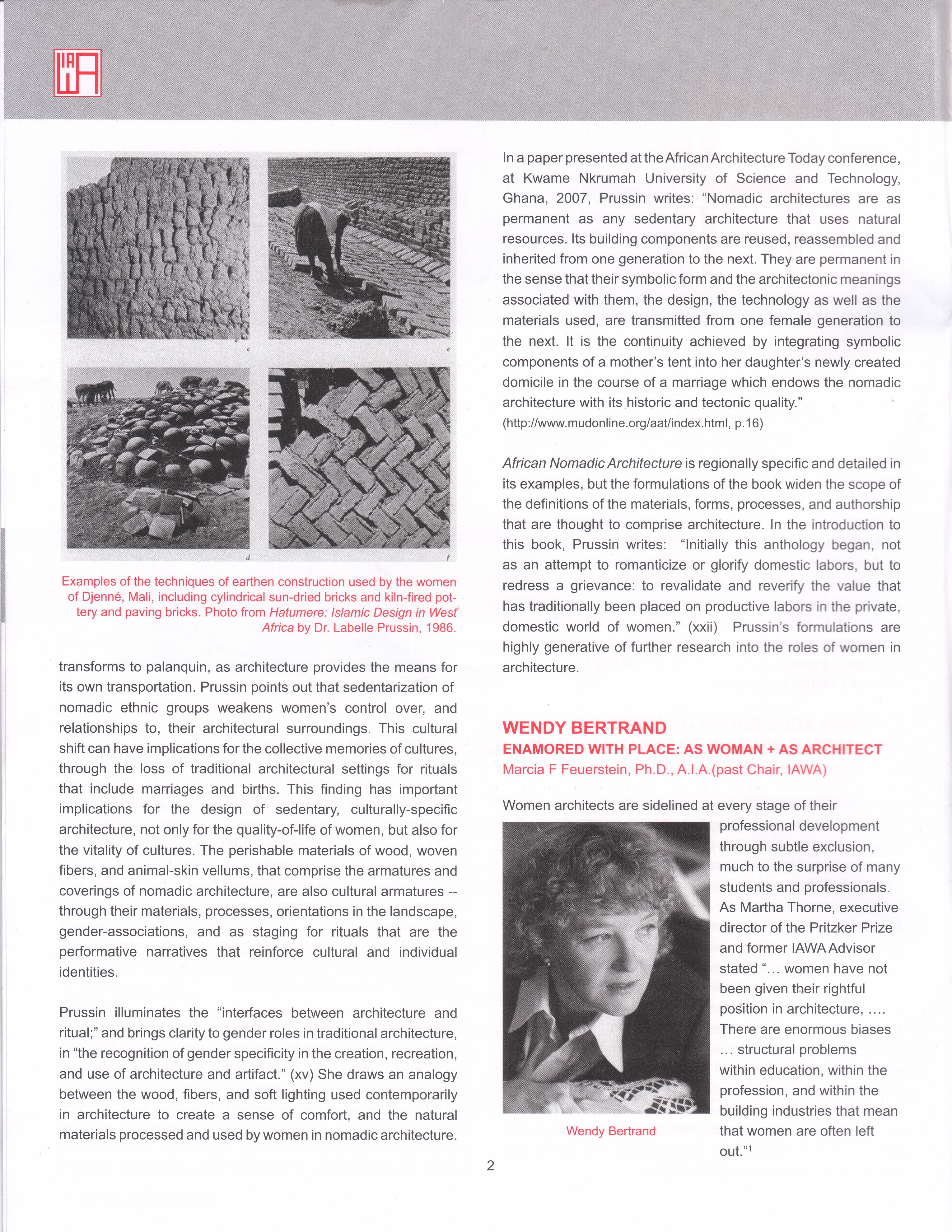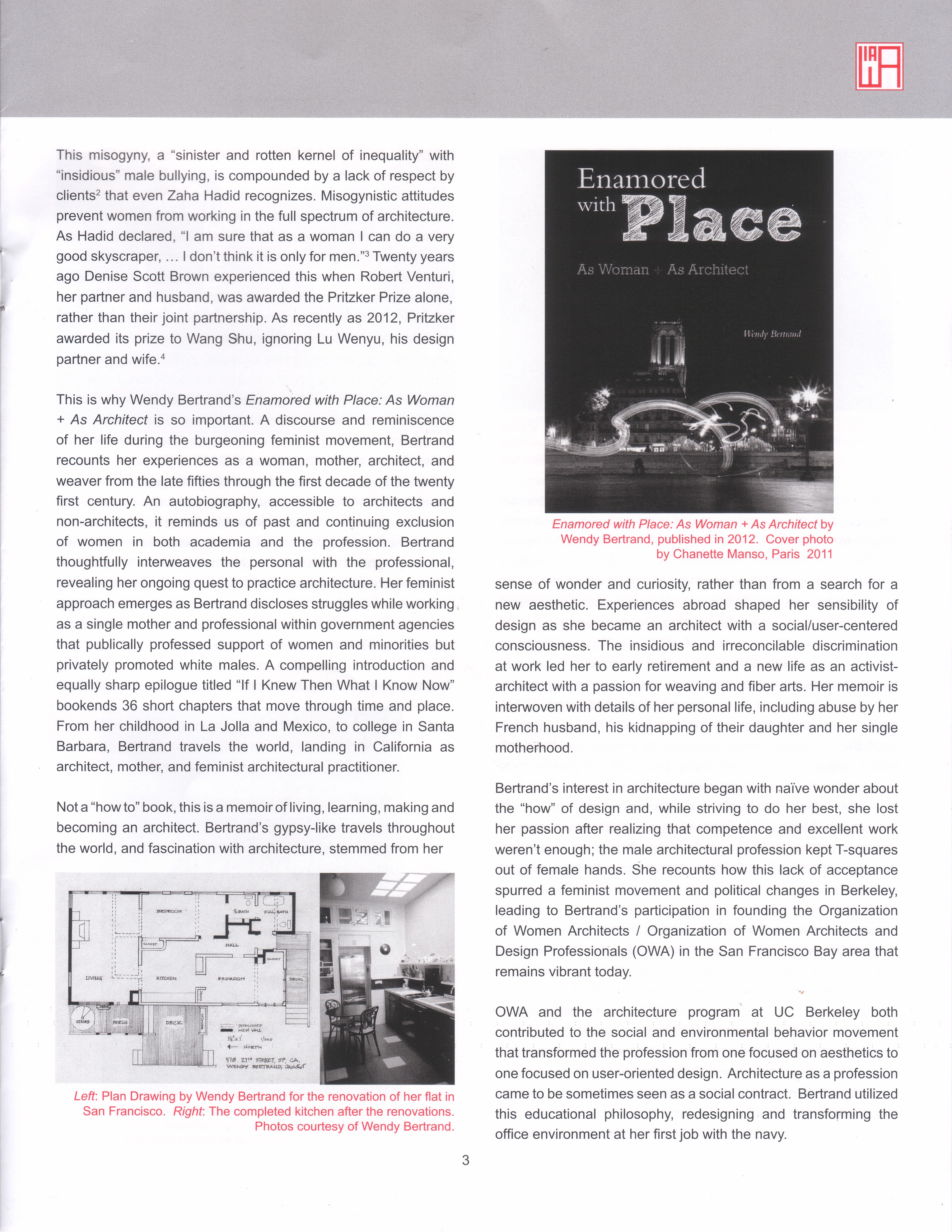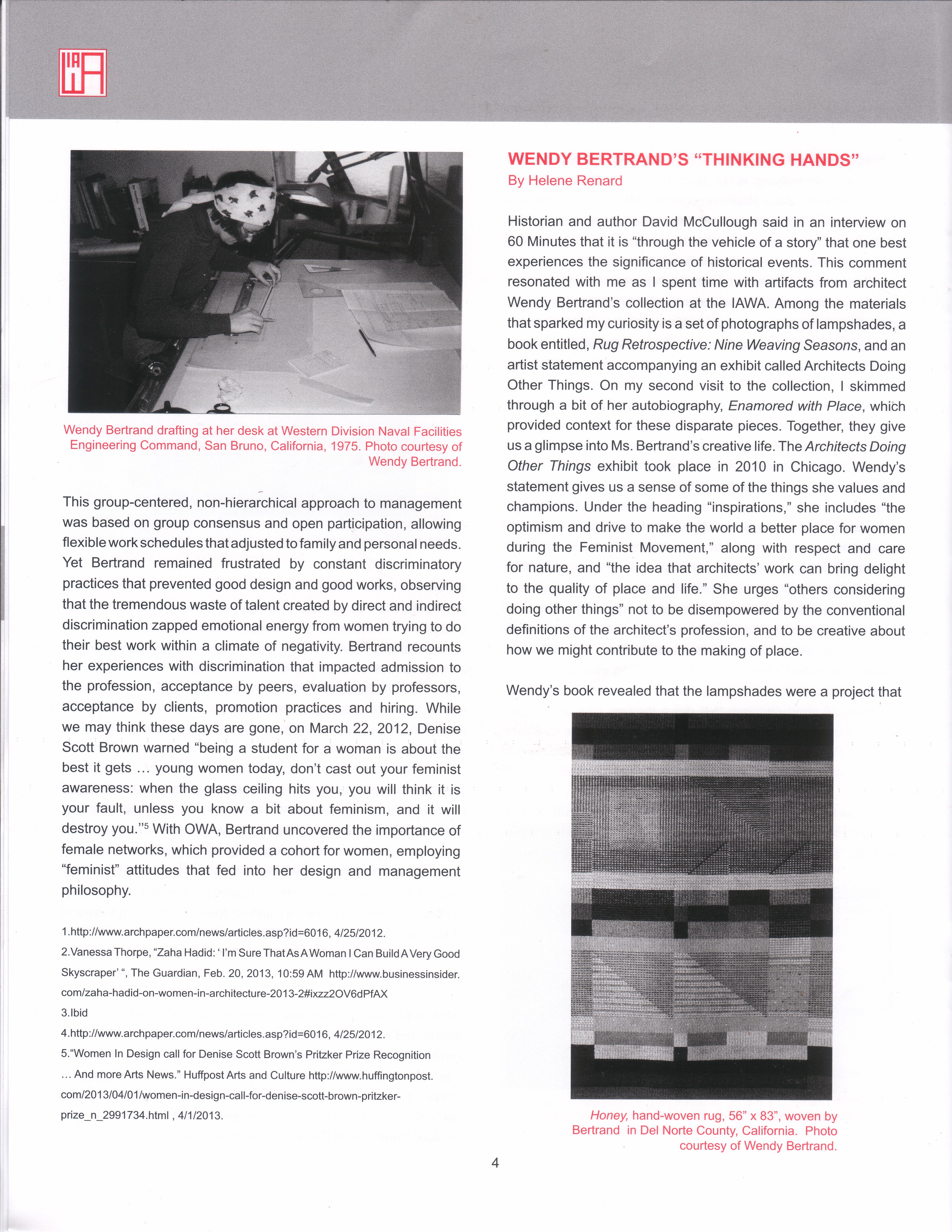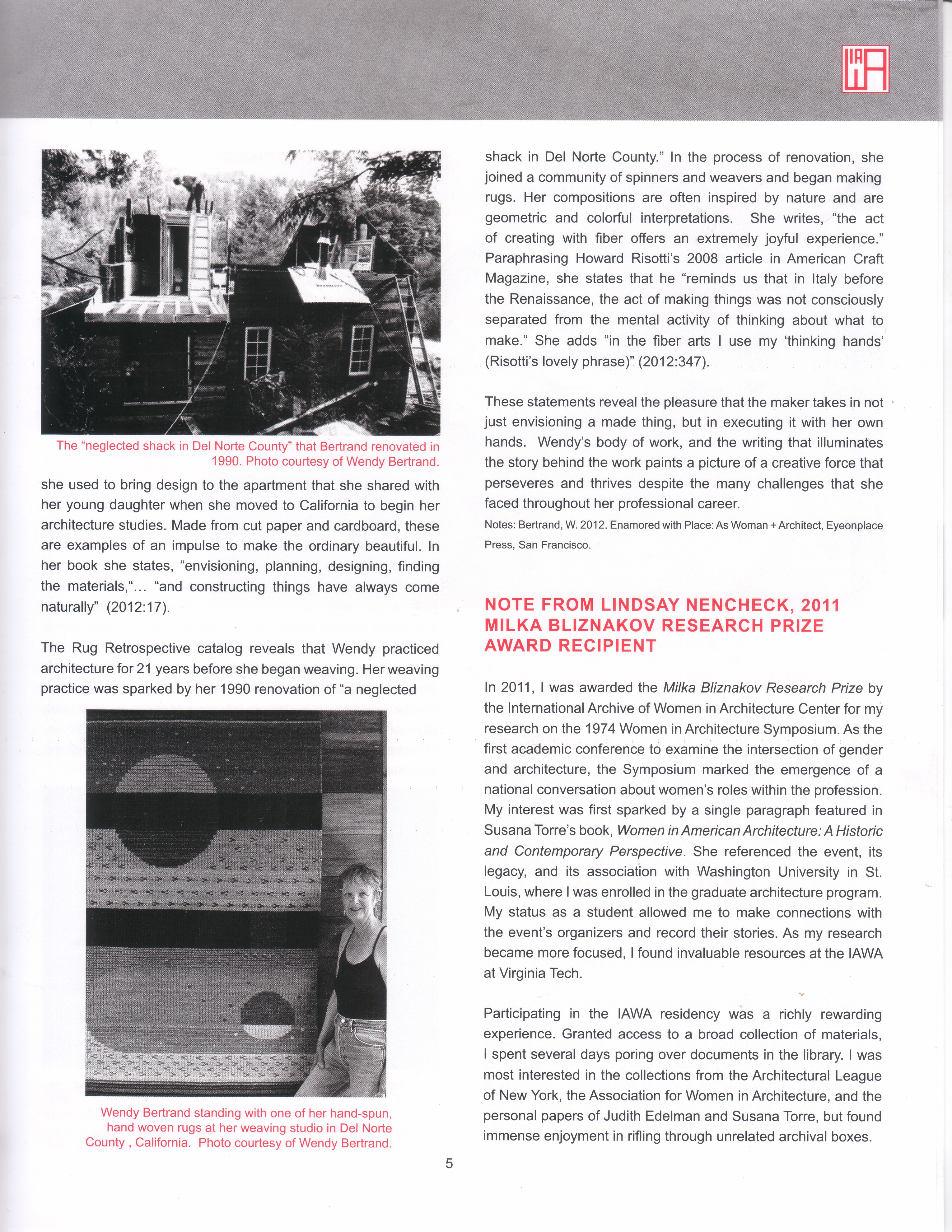Winter 2013 The Redwood Coast REVIEW
A Publication of Friends of Coast Community Library in Cooperation with the Independent Coast Observer
ARCHITECTURE By Her Own Design Volumn 15, Number 1, page 1 and 10
http://www.stephenkessler.com/rcr/rcr_2013win.pdf
The Redwood Coast REVIEW
Volume 15, Number 1 Review Winter 2013 architecture
A Publication of Friends of Coast Community Library in Cooperation with the Independent Coast Observer
By Her Own Design by Zara Raab Photos not included.
The young Wendy Bertrand was one of twelve pioneering Bay Area women who gathered to share their experiences in a traditionally male-dominated field. The group, Organization of Women Architects (OWA), is still a place where women trade ideas and support in their professional and personal lives. It is hard to overestimate the role of such organizations in the burgeoning Women’s Movement of the 1970s, as witnessed in Bertrand’s inventive, creatively designed memoir and social history of the era, Enamored with Place: As Woman, As Architect (Eye on Place, 2012).
The young Bertrand, recently graduated from Berkeley’s architectural degree program, soon begins a long career in government, overseeing architectural projects for the Navy, while all the time single-handedly raising her daughter.
So her daughter can attend the French- American Bilingual School in San Francisco, Bertrand buys a charming, weathered “Workers’ Victorian” on a steep hill in San Francisco in 1975, calling it her maisonette. Bertrand is passionate, throwing herself into both her career and maisonette on 27th Street, with its vistas of the Bay and East Bay hills. From the moment she moves in, this house becomes one of two true loves of her life. (The second is a cabin in Gasquet in remote Northern California.) “I slowly engaged in a tenderly curious acquaintance with my living space,” Bertrand writes, “exploring the limitations and opportunities” of the space, as “preening and nesting became an integral part” of her San Francisco life. Bertrand pays attention to her space as she might to a lover or as a mother attends her child. Like any artist, she undertakes the house in large part because she sees its possibilities. “How could I hold on to the house’s century-old character while still making the place contemporary? What could be done to catch the country feeling in the city—with modesty and elegance?”
Not only her architectural training, but also Bertrand’s youthful travels guide her renovations as she recalls the domestic arrangement in other cultures, where “sleeping took place next to clay fire pits for cooking, low tables for entertaining, cribs for childcare, stools for repairing tools, and nooks for musical instruments or materials for crafts.” As the Mirabelle plum tree in her yard blooms over the decades, putting forth its white petals and then its tiny, delicate golden plums, Bertrand extends and reshapes the spaces of the maisonette, thinking of the bedrooms as not simply “nighttime caves” or “master bedrooms” (that “rudely ringing title”) but as spaces for enriching active daily life. Like every artist, Bertrand revises, adding a small balcony here, an office nook there, first painting the ceiling of her the lean-to bathroom a disastrous salmon, then repainting it a softer yellow.
These are the “socially more progressive years” of the 1970s, when workplaces celebrated International Women’s Years, as well as the history of African-Americans, Hispanics and Asian Americans. Bertrand works hard, studying time management and negotiating skills, the better to compete with male colleagues for management positions. She takes bold steps attempting to succeed in a man’s world—pushing herself to stand up and speak in work meetings, spreading her arms to take up more space (and claim more status), dressing smartly, and––knowing that men tend to share information in social situations––playing tennis with male colleagues. Year by year, she struggles up the Navy’s organizational ladder, eventually qualifying for government service positions at a high level (GS-14), but she often has to fight for architectural jobs that invariably go to men.
After being turned down for one job, citing discrimination she appeals the Navy’s decision, without success, and suffers reprisals as a result. She writes, “While I was busy holding off the discrimination I perceived above the waterline, the full masculinity of architecture lay out of sight, hidden like the underwater depths of an iceberg.” By most measures, however, Bertrand has extraordinary success in the male-dominated Navy. Early on, she handles herself with aplomb as the only woman architect on a panel awarding government projects. When one firm wedges images of sexy women in bathing suits in among their presentation slides, the firm’s principal approaches her afterward to apologize. “It won’t happen again,” he says, and she replies, “I hope not.” Her keen eye notes the now-antiquated social behaviors at meetings of the American Institute of Architects (AIA), with its “constant drip of mini-comments from the old guard about being female.”
Overseeing building projects, Bertrand is able to influence design on some large projects (making sure, for example, that all government offices in her portfolio had windows). As Bertrand’s illustrations and photographs show, one of her many projects, San Diego’s Marine Corps Recruit Depot, has a California Mission architectural style with handsome red tile roofs, as well as parks and paths that create a campus-like feel. Professional organizations are her “shortcuts for learning professional and organizational skills,” and she makes skillful use of them, serving on the board of Society of American Military Engineers (SAME), a less stuffy, more open-minded group than the white, male elitist American Institute of Architects.
Bertrand’s career takes off. While her romantic involvements are problematic, she excels at management, whether it is a major architectural project for the Navy or joining work- men to retile the shower in her maisonette. Bertrand knows this, noting, “Working well together productively is one of the true and universal pleasures of living.” Understanding employees differs from empathy in intimate relationships, and it is in intimate relationships that Bertrand’s take-charge attitude—the very thing that carried her forward in her career—sometimes worked against her. She seems to pay a high price for years of working in an intensely competitive mostly male environment, as her intimate relationships, while satisfying, are not lasting; one romance after another––typically with much younger men––unwinds in two years or so. “My love life,” she writes expressively, “was flaking away like the old paint on my house before its make-over.”
Insert: “Buildings form the social stamp of their time. Like judges setting precedents with their decisions from the bench, we architects mark the land with our structures.” —Wendy Bertrand
Two-thirds of the way through Enamored with Place, I felt nothing but admiration for Wendy Bertrand’s spunk as a trailblazer for Bay Area women architects and as a leader in boosting awareness of the social and human implications of the built environment. Apart from my annoyance with her overuse of acronyms, I found myself wishing more stalwart, more-or-less ordinary people like Bertrand wrote memoirs to counterbalance the current flood of “Poor Me” tales. This impression is dispelled only briefly in the last third of the book, when the various strands of Bertrand’s personal life, particularly her relationship with her daughter, begin to unravel.
Bertrand raises her daughter without financial or other assistance from her father, who apart from occasional stints on the West Coast as a ski coach, remains in France. (Bertrand wisely declines his invitation to live with him and his mistress there.) Enamored is in part a social history of an era when women like Bertrand, bereft of adequate childcare options, struggled to care for their children while holding onto gains in the workplace and in their careers. Bertrand’s daughter has much the same kind of 1950s upbringing Bertrand herself had growing up in La Jolla. Bertrand, too, was a latchkey child, at a time when single motherhood in the white middle class was rare. Was there an unacknowledged price paid for all that freedom––freedom to travel around the world on her own before finishing college, when with extraordinary independence the young Bertrand meets the Marxist who becomes her husband and father of her child, with never so much as an introduction to her own family in the States? Still barely out of her teens, Bertrand returns––alone––to California with her baby to take up her studies at UC Berkeley, and with unusual stamina graduates with honors in 1971 and the following year earns her Master’s degree.
Bertrand’s daughter, too, is given a stable childhood, with consistent, but moderate to minimum involvement from Bertrand or her grandmother, and very little from her father. The world, however, was a very different place in the 1970s, when the supporting culture of towns and neighborhoods was eroded. It is at this point, in her daughter’s teen years, that Bertrand loses her sense of perspective. What mother, where her children are concerned, does not?
Even when there are setbacks, however, Bertrand moves forward, finding meaning and satisfaction. Her daughter eventually becomes independent and marries; Bertrand becomes the manager of the new Architectural Branch of the Navy Public Works Center in Oakland. Bertrand’s consistent interest in progressive management means she acknowledges her subordinates’ participation in what would otherwise be a faceless bureaucracy. A good manager, interested in the professional development of subordinates, she arranges for weekly staff meetings––unusual at the time––and expects people to participate, just as in 1977 she had organized “Priorities Ahead” to give younger architects a forum for presenting their ideas. She goes above and beyond the call of duty at work, but after six years recognizes that somewhere along the line she has lost her sense of fun. “Perhaps my sense of humor had been quieted from many battles for inclusion.” Work is lonely with no other managers to socialize with. She knits at her desk.
Completing a prestigious executive training program, which qualifies her for GS-14 positions, she can no longer tolerate the baldly discriminatory attitudes around her, and in the end takes a lateral move to the Forest Service. Her love of architecture and lived spaces is undiminished, but her desire to live in a man’s world is extinguished. She joins the Bay Area Knitting and Crochet Guild, and takes up fiber arts, all the while continuing to be active in the Organization of Women Architects, which she helped found in the early 1970s. Bertrand writes: “Buildings are prominent components of place; they impact appearance, character, circulation, vistas, environmental health, resource use, and future options. But perhaps even more intriguing to me is the way buildings form the social stamp of their time. Like judges setting precedents with their decisions from the bench, we architects mark the land with our structures.”
Bertrand is retired from civil service and now divides her time between her beloved maisonette in San Francisco and her equally beloved cottage in Gasquet in Northern California, where she has built a studio for her fiber art and exquisite rug-making. Her book Rug Retrospective of Weaving Seasons 1999-2010, which displays her gorgeous rugs, is in its fourth edition.
She is a woman of her time—how could she be otherwise? Though her energies were perhaps occasionally diverted, first by the hedonism and extroversion of the 1970s and 1980s, and then by the ambition of the 1990s, Bertrand admirably completed the professional and domestic renovations she set out for herself, and on the way became an accomplished and heroic twenty-first-century woman.




